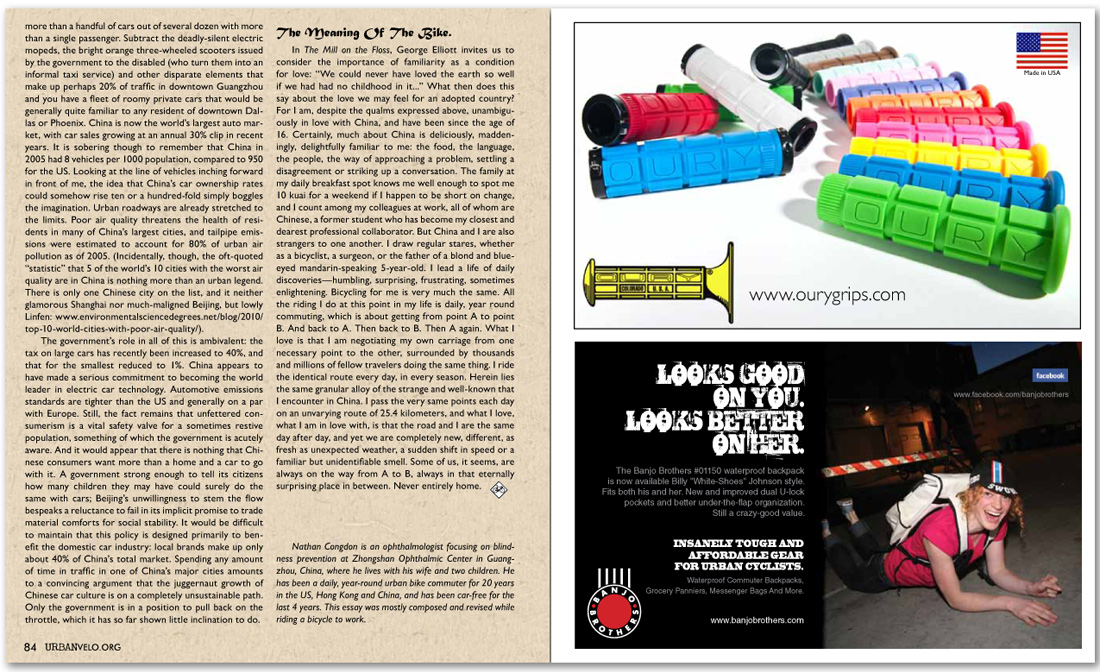


more than a handful of cars out of several dozen with more than a single passenger. Subtract the deadly-silent electric mopeds, the bright orange three-wheeled scooters issued by the government to the disabled (who turn them into an informal taxi service) and other disparate elements that make up perhaps 20% of traffic in downtown Guangzhou and you have a fleet of roomy private cars that would be generally quite familiar to any resident of downtown Dallas or Phoenix. China is now the world’s largest auto market, with car sales growing at an annual 30% clip in recent years. It is sobering though to remember that China in 2005 had 8 vehicles per 1000 population, compared to 950 for the US. Looking at the line of vehicles inching forward in front of me, the idea that China’s car ownership rates could somehow rise ten or a hundred-fold simply boggles the imagination. Urban roadways are already stretched to the limits. Poor air quality threatens the health of residents in many of China’s largest cities, and tailpipe emissions were estimated to account for 80% of urban air pollution as of 2005. (Incidentally, though, the oft-quoted “statistic” that 5 of the world’s 10 cities with the worst air quality are in China is nothing more than an urban legend. There is only one Chinese city on the list, and it neither glamorous Shanghai nor much-maligned Beijing, but lowly Linfen: www.environmentalsciencedegrees.net/blog/2010/top-10-world-cities-with-poor-air-quality/).
The government’s role in all of this is ambivalent: the tax on large cars has recently been increased to 40%, and that for the smallest reduced to 1%. China appears to have made a serious commitment to becoming the world leader in electric car technology. Automotive emissions standards are tighter than the US and generally on a par with Europe. Still, the fact remains that unfettered consumerism is a vital safety valve for a sometimes restive population, something of which the government is acutely aware. And it would appear that there is nothing that Chinese consumers want more than a home and a car to go with it. A government strong enough to tell its citizens how many children they may have could surely do the same with cars; Beijing’s unwillingness to stem the flow bespeaks a reluctance to fail in its implicit promise to trade material comforts for social stability. It would be difficult to maintain that this policy is designed primarily to benefit the domestic car industry: local brands make up only about 40% of China’s total market. Spending any amount of time in traffic in one of China’s major cities amounts to a convincing argument that the juggernaut growth of Chinese car culture is on a completely unsustainable path. Only the government is in a position to pull back on the throttle, which it has so far shown little inclination to do.
The Meaning Of The Bike.
In The Mill on the Floss, George Elliott invites us to consider the importance of familiarity as a condition for love: “We could never have loved the earth so well if we had had no childhood in it...” What then does this say about the love we may feel for an adopted country? For I am, despite the qualms expressed above, unambiguously in love with China, and have been since the age of 16. Certainly, much about China is deliciously, maddeningly, delightfully familiar to me: the food, the language, the people, the way of approaching a problem, settling a disagreement or striking up a conversation. The family at my daily breakfast spot knows me well enough to spot me 10 kuai for a weekend if I happen to be short on change, and I count among my colleagues at work, all of whom are Chinese, a former student who has become my closest and dearest professional collaborator. But China and I are also strangers to one another. I draw regular stares, whether as a bicyclist, a surgeon, or the father of a blond and blue-eyed mandarin-speaking 5-year-old. I lead a life of daily discoveries—humbling, surprising, frustrating, sometimes enlightening. Bicycling for me is very much the same. All the riding I do at this point in my life is daily, year round commuting, which is about getting from point A to point B. And back to A. Then back to B. Then A again. What I love is that I am negotiating my own carriage from one necessary point to the other, surrounded by thousands and millions of fellow travelers doing the same thing. I ride the identical route every day, in every season. Herein lies the same granular alloy of the strange and well-known that I encounter in China. I pass the very same points each day on an unvarying route of 25.4 kilometers, and what I love, what I am in love with, is that the road and I are the same day after day, and yet we are completely new, different, as fresh as unexpected weather, a sudden shift in speed or a familiar but unidentifiable smell. Some of us, it seems, are always on the way from A to B, always in that eternally surprising place in between. Never entirely home.
Nathan Congdon is an ophthalmologist focusing on blindness prevention at Zhongshan Ophthalmic Center in Guangzhou, China, where he lives with his wife and two children. He has been a daily, year-round urban bike commuter for 20 years in the US, Hong Kong and China, and has been car-free for the last 4 years. This essay was mostly composed and revised while riding a bicycle to work.